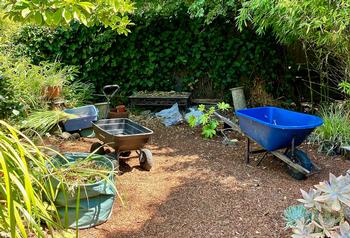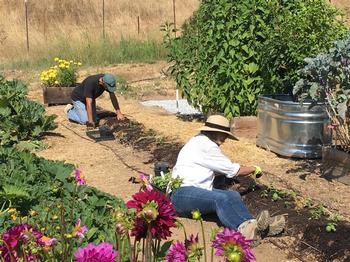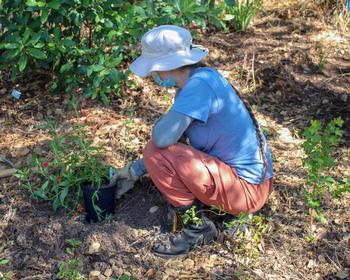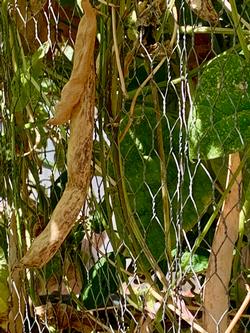'Tis a New Season
-
Dot Zanotti Ingels
-
Fall is here, and we are all shifting gears into shorter daylight hours and cooler temperatures. Fall is also an important time in your garden. It is a time to put your garden to bed and plan and plant for the future.
 Much of the health of your garden depends on doing your fall chores. Credit: Barbara Robertson
Much of the health of your garden depends on doing your fall chores. Credit: Barbara RobertsonAt best, this has been a challenging year for Marin gardeners. We have adapted to giving our plants so much less water than they would like. But much of the health of your garden depends on doing your fall chores, especially when there has been so much stress on the plants during this challenging drought year. Fall is also a good time to evaluate how fire-smart your landscape is and make needed changes.
It is essential to do a thorough garden cleanup.
- Before you start your fall cleanup, make a map of where you planted your veggies this year. You do not want to keep planting the same thing in the same place every year since this can lead to disease and a lack of soil nutrients that that type of plants need to thrive. For your perennials like bulbs, you will know where they are in the spring.
 Fall is a great time to plant cool-weather veggies such as peas, lettuces, onions, cabbages, broccoli, and kale. Credit: Gael Perrin
Fall is a great time to plant cool-weather veggies such as peas, lettuces, onions, cabbages, broccoli, and kale. Credit: Gael Perrin - Clean away diseased and damaged plant material to reduce fuel load, and reduce the chances of diseases overwintering. Place diseased material into your green can instead of your compost pile.
- Perennial plants stay in the ground year-round, but they still need our attention. You can cut back spent plants like daisies, scabiosa and hostas to a height of 3-6 inches or leave the seed pods for the birds.
- Now is a good time to divide perennials such as iris, daylilies, hostas, coneflowers and yarrow. They benefit by being less crowded and you get better flowering.
- Keep on keeping on with weed pulling before they go to seed and make more weeds for you to pull.
 Fall is the best time to plant trees, shrubs, perennials, and native plants. Credit: Richard Ackley
Fall is the best time to plant trees, shrubs, perennials, and native plants. Credit: Richard Ackley
It also a time to plan ahead.
- Now is the best time to plant trees, shrubs, native plants and perennials. Fall and winter rains (fingers crossed) will help them establish thriving root systems for the new year’s growth.
- Fall is the time to plant spring bulbs.
- It is also a great time to plant cool-weather veggies such as peas, lettuces, onions, cabbages, broccoli and kale.
- To improve the health of your soil for next year’s crop, covering your vegetable garden soil is a good gardening practice. Applying 3-6 inches of an organic mulch or compost creates a home and provides food for all the microorganisms within the soil. Make sure any organic material is free of weeds or seed heads. Also, assure that wood mulch is kept five feet away from any structure for fire safety. Healthy garden leaves are garden gold for your soil. Shred them before putting them on top to prevent matting. Planting a cover crop in your beds provides food for valuable soil microorganisms, suppresses weeds, and returns organic material and nutrients to the soil. Legumes such as fava beans and vetch planted in the fall add nitrogen to the soil. These seeds are cheaper to buy in bulk.
- Clean your garden tools before putting them away for the winter by washing them thoroughly and oil metal parts to prevent rust. They may need a sharpening too. Sharp tools make your work easier and safer. Empty and wash out your spraying equipment with soap and water both inside and out and allow them to dry thoroughly.
 The seeds in these Romano beans are almost ready for saving. Credit: Dot Ingels
The seeds in these Romano beans are almost ready for saving. Credit: Dot Ingels - As your annuals start to fade, let some go to seed so you can collect them for next year’s garden. This is a money saving and fun thing to do.
- Organize your garden shed to get rid of things that no longer work or are in the way. Store your labels and cages. Double check what you used this season to see if anything needs replacing over the winter.
Lastly, let’s hope for a wet winter as we peruse seed catalogs in front of a cozy fire.
Sponsored by UC Cooperative Extension, the University of California Marin Master Gardeners provide science- and research-based information for home gardeners. Email questions to helpdesk@marinmg.org. Attach photos for inquiries about plant pests or diseases. The office is closed for drop-in visits. Subscribe to the Leaflet, UC Marin Master Gardener's free quarterly e-newsletter, at marinmg.ucanr.edu.




